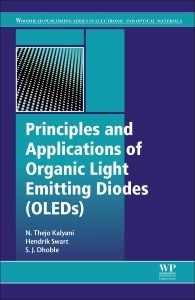Description
Principles and Applications of Organic Light Emitting Diodes (OLEDs)
Woodhead Publishing Series in Electronic and Optical Materials Series
Authors: Kalyani N. Thejo, Swart Hendrik C., Dhoble Sanjay J.
Language: English
Subjects for Principles and Applications of Organic Light Emitting...:
Keywords
4K ultra HD TV; 4K ultraHD TV; Alq3; Antenna effect; Artificial lighting; Artificial sky glow; CCT; CIE; CRI; Carbon foot prints; Charge transfer; Climate smart lighting; Degradation; Dendrimers; Device architecture; E-paper; Fabrication; Flat-panel displays; Flexible displays; Fluorescence; HOMO; Handheld devices; Hetero aromatic polymers; Industrial challenges; LEDs; LUMO; Lifetime; Lighting revolution; Luminescence; Luminescent lamps; OLED; OLED devices; OLED fabrication; OLEDs; Organic compounds; Organic semiconductors; Phosphorescence; Pollution free; Polymers; Quinolone-based polymers; RGB emissive materials; Rare earths; Screening effect; Small molecules; Solid state lighting; Solid-state lighting; Solution techniques; Tactile technology; Ultrathin displays; Vacuum deposition techniques; Virtual curtains
204.32 €
In Print (Delivery period: 14 days).
Add to cartSupport: Print on demand
Description
/li>Contents
/li>Readership
/li>Biography
/li>Comment
/li>
Principles and Applications of Organic Light Emitting Diodes (OLEDs)explores the ways in which the development of organic semiconductor materials is opening up new applications in electronic and optoelectronic luminescent devices.
The book begins by covering the principles of luminescence and the luminescent properties of organic semiconductors. It then covers the development of luminescent materials for OLEDs, discussing the advantages and disadvantages of organic versus inorganic luminescent materials. The fabrication and characterization of OLEDs is also covered in detail, including information on, and comparisons of, vacuum deposition and solution techniques.
Finally, applications of OLEDs are explored, including OLEDs in solid-state lighting, colored lighting, displays and potential future applications, such as ultra-thin and flexible technologies.
This book is an excellent resource both for experts and newcomers to the field of organic optoelectronics and OLEDs. It is ideal for scientists working on optical devices, lighting, display and imaging technologies, and for all those engaged in research in photonics, luminescence and optical materials.
1. Principles of Luminescence 2. Luminescence in organic semiconductors 3. Evolution of luminescent materials for OLEDs 4. OLED fabrication and characterization 5. Artificial lighting and the role of OLEDs 6. Solid state lighting and displays 7. OLEDs as light sources: materials, synthesis and devices 8. Green, white and blue OLEDs and devices 9. OLEDs for displays 10. Future trends in OLEDs: materials and devices
Prof. Hendrik C Swart is a B1 NRF rated researcher (Internationally acclaimed researchers) and currently a senior professor in the Department of Physics at the University of the Free State. Over the past 22 years he has led research in the area of the degradation of phosphors for field emission displays, as well as developing materials for nano solid state lighting. He has been key in the development of processes to synthesize and deposit thin films of various types of semiconductor nano-particles which will enhance the color, luminescent intensity and lifetime of such displays. He has more than 650 publications in international peer reviewed journals.
Prof. Sanjay J. Dhoble is presently working as a professor in the Department of Physics at R.T.M. Nagpur University, Nagpur, India. During his research career, he has worked on the synthesis and characterization of solid-state lighting materials, as well as the development of radiation dosimetry phosphors using thermoluminescence techniques and utilization of fly ash. Dr. Dhoble has more than 780 research publications in international and national peer-reviewed journals, more than 582 research papers are published in Scopus-indexed journals. Dr. Dhoble is an Editor of the journal Luminescence.
- Provides a one-stop guide to OLED technology for the benefit of newcomers to the field of organic optoelectronics
- Comprehensively covers the luminescent properties of organic semiconductors and their development into OLED materials
- Offers practical information on OLED fabrication and their applications in solid-state lighting and displays, making this essential reading for optoelectronics engineers and materials scientists




